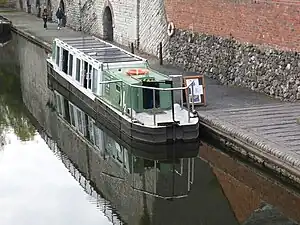Ross Barlow
The canal boat Ross Barlow is a hybrid hydrogen narrowboat, power-assisted by an electric motor whose electricity is supplied by a fuel cell or a battery. It debuted on 21 September 2007.
 At the Black Country Living Museum in 2014 | |
| History | |
|---|---|
| Launched | 21 September 2007 |
| General characteristics | |
| Type | Narrow boat |
| Installed power | hybrid hydrogen fuel cell |
| Propulsion | Permanent magnet brushed DC electric motor |
History
The Protium Project[1] at the University of Birmingham started at the beginning of 2006. The boat is named in memory of a postgraduate student who was killed in a hang gliding accident in March 2005 at the age of 25. He had worked on the project in its early stages and was an enthusiastic supporter of sustainable energy.[2]
Refueling
The fixed tanks are refuelled at a waterway hydrogen station. The hydrogen is generated by electrolysis using solar or wind turbines.
Specifications

Storage: 2.5 kilograms (5.5 lb) of hydrogen at 10-bar (1,000 kPa) in 5 Ti-V-Mn-Fe[3] metal hydride solid-state hydrogen tanks,[4] a lead acid battery stack, a 5-kW PEM fuel cell and a high torque NdFeB permanent magnet brushed DC electric motor.
See also
References
- "Protium: Hydrogen canal boat". Hydrogen Materials Group. University of Birmingham.
- "The Ross Barlow: a zero-emission hydrogen hybrid canal boat". Antidote Counteragent. Retrieved 6 June 2013.
- "Hydrogen Hybrid Canal Boat". Green Car Congress. 24 September 2007.
- "In detail" (PDF).
External links
- "Hydrogen Hybrid Canal Boat: Clean and Silent Propulsion for the Inland Waterways" (Press release). University of Birmingham. Archived from the original on 2 October 2007.
